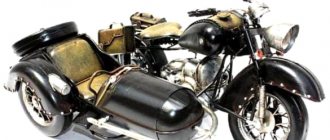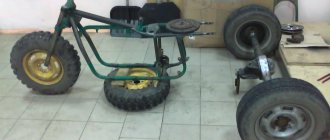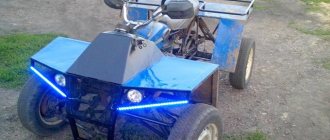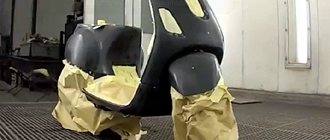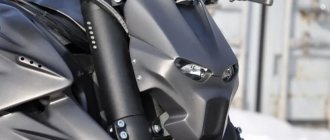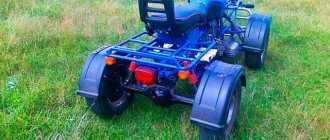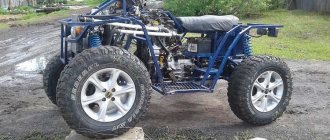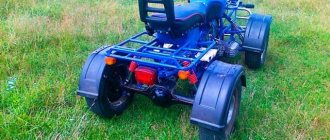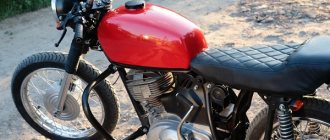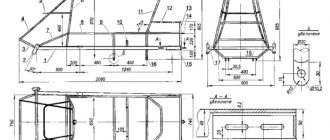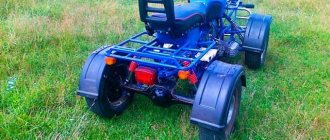How to make an ATV with your own hands is a difficult and responsible task, but feasible for a master who has mastered welding and turning. The effort and time spent are paid off not only by large savings, but also by the result obtained - an exclusive, original model of a quadric that no one else has.
Features of assembling a homemade vehicle highly depend on the chosen base - the engine and other elements that are used by the craftsman.
6 best options for a base (“donor”) for those who have set the goal of how to make an ATV.
- Motorcycle "Ural".
- Motorcycle "Izh".
- Motor scooter "Ant".
- Another motor scooter (scooter).
- Car "Niva".
- Oka car.
Most often, some structural elements are taken from a motorcycle, others from a car.
In addition to the parts (components) for the quadric, its creator will need:
- assembly “shop” - a fairly spacious garage equipped with good heating and lighting will be useful in this capacity;
- a set of equipment and tools;
- blueprints.
You may also be interested in an article from our specialist, which talks about how to make a mobile home with your own hands.
Preparation for work, tools and equipment
First of all, you need to carefully consider when, where and for what purposes the future ATV will be used - hunting and fishing, motorcycling in nature, transporting goods, etc. It is on this basis that you need to make a choice of a “donor” vehicle, deciding how powerful the engine is needed, what kind of suspension is suitable, what kind of trunk, etc.
You can take ready-made drawings from the Internet, create them from scratch yourself, or combine both options and ready to remake them at your own discretion.
List of required tools:
- welding machine;
- Bulgarian;
- drill;
- a set of keys;
- various small tools - calipers, hammer, knife, screwdrivers, pliers, etc.
To make your own frame, you will also need equipment for bending pipes. If you don’t have one, you can rent it or outsource the necessary work to another craftsman. Only with remarkable skill can you bend the pipes manually by heating the bend with a gas cutter or torch.
Quad components:
- engine;
- frame;
- rear and front suspension;
- steering;
- brake system;
- cooling system;
- muffler;
- electrical equipment - battery, headlights;
- body, body kit
It is strongly recommended to purchase a brake system either completely new or from a vehicle with the shortest mileage. Using old brakes is too dangerous.
It is quite possible to make a muffler yourself. Everything else is to purchase used parts on the shadow market.
Homemade 4x4 ATV based on OKI and other equipment
We present to you a 4x4 ATV model with all-wheel drive, which is designed to conquer off-road spaces.
This model was constructed by assembling various components, assemblies and parts of automotive vehicles from different manufacturers and brands - these are both domestic and foreign models. The ATV is assembled on the basis of an OKA vehicle. Technical characteristics of the assembled ATV model: - parameters of width 1 m 55 cm, base 1 m 60 cm; - height parameters from the steering wheel 1 m 30 cm, from the seat 90 cm; - clearance height 43 cm; - weight 390-410 kg; - an engine from OKA was installed; -installed axle gearboxes from Mitsubishi; -rear and front steering knuckles and hubs from Niva; -use of Niva drive; -front and rear suspensions are installed on double wishbones; - torsion bars and springs are used as elastic elements; -Power steering from Subaru; - the center and cross-axle differentials are locked.
Step-by-step assembly of an ATV
1. We prepare diagonal spacers-amplifiers with a lever. Pipe Ф21х4.
2. the suspension has 4 levers, 2 for 1 lever = 16 units;
3. Turning work according to the drawing of the gearbox adapter. Centering and balancing.
4. Assembling suspension arms.
5. We used a steering rack, in particular a hydraulic distributor, from Toyota; after grinding the gear, we attach the cardan and insert it into the section of the steering shaft. Thanks to this we have a tight connection.
6. The ear is welded. hydraulic cylinder to the bipod, placing one side to the frame and the other to the rod.
7. Use of hydraulic booster without changing designs.
8. We shorten the cylinder to the required size for compactness.
9. Setting up the front suspension, next in line are the elastic elements.
10. We use springs from the Urals complete with shock absorbers, installing 1 piece on the front axle. on the wheel.
11. Torsion bar front and rear suspension, and other parts according to the drawing.
12. The transmission is almost assembled, the next step is to finalize the external frame.
Having completed the assembly according to the design drawings, we form and make the design. Very interesting, but painstaking and time-consuming work.
Parts selection
ATV frame
Depending on the “donor” and the design of the quad, you either have to make the frame yourself, or you can reconstruct a finished, used one.
The most important thing is that the engine is securely bolted to the bottom along the frame, which can be located either front or rear. The transmission and drive should also be firmly attached to the frame to avoid play.
Homemade frame
The material used is ordinary water and gas pipes with a wall thickness of no more than 3 mm:
- for spars - 25 mm;
- for crossbars and struts - 20 mm.
The pipes are connected using spot welding, followed by solid welding. Ears for attaching shock absorbers and levers are welded to the frame immediately. Brackets - during installation of units and components.
Reconstruction of an existing frame
To reconstruct a finished frame, you should remove everything, leaving the frame, dismantle the back part and build up the front. Then weld elements for fastening a complete set of components and assemblies of the ATV. When reconstructing a motorcycle frame, the seatposts should be moved back by 40 - 45 cm.
The front and rear luggage racks are cut out of a metal sheet and welded to the frame. Finally, the finished frame is painted; there is no need to varnish it.
Additionally, we recommend reading our expert’s article on how to choose a roof rack for your car.
We also recommend reading our specialist’s article, from which you will learn how to select and install a box on the roof of a car.
Engine
The engine is suitable for a car, motorcycle or scooter. Some “Lefties” even construct an ATV from a walk-behind tractor with their own hands, since newer models are equipped with four-stroke engines, the power of which in heavy devices reaches 15 “horses” - versus 11 hp. "Ant."
The engine of a scooter has the advantage of low fuel consumption; in addition, the scooter-based quad is the lightest, which makes it easy to pull it out when stuck in mud and sand. But a quad to transport cargo and/or drive off-road requires a more powerful engine.
The engine power of the Izh-1, Izh-2 and Izh Jupiter is 24 hp, the old Ural is 32 or 36 hp, the two-cylinder engine of the old Oka is 35 hp. , a three-cylinder car of a later release - 53.
To travel in hot weather, the ATV needs a cooled engine. Cooling was not installed on older motorcycles, so you will have to pick it up (for example, from a VAZ 2108 will do) and install it.
Suspension
The suspension can be used both rear and front. The easiest way is to take the front one from a motorcycle.
2 rear suspension options:
- The rear axle of the car, shortened to fit the dimensions of a quad. The advantage is the presence of a differential. Disadvantage - the design will be heavier.
- Cardan-gear design - with a gearbox mounted on the rear axle.
Please note: the quad all-terrain vehicle requires an independent suspension with high ground clearance.
The suspension arms are bolted to the frame through rubber-metal hinges - silent blocks.
The front suspension strut must be tilted, otherwise the ATV may roll over.
The shock absorbers are suitable from Izha, but if the budget allows you to purchase gas-oil shock absorbers with pumping, the driver will be able to adjust the suspension according to road conditions.
Steering and chassis
The steering system of an ATV can be based on a car - with a steering wheel, or with a motorcycle steering wheel. Some craftsmen combine both types: motorcycle handlebars, levers and shafts at the top, car tie rods at the bottom. It is advisable to take the fuel tank along with the motorcycle handlebars.
A homemade steering shaft is made from a 20 mm pipe with walls up to 3 mm. A travel limiter must be installed at the bottom.
When making a quad on a car base, it is better to replace a gear pair with a chain drive. This will greatly simplify and reduce the cost of maintenance.
We recommend a manual gearbox, since it improves maneuverability; moreover, when driving an ATV, you still have to shift the rear, low or high gear manually.
The input shafts from the gearbox must be directed directly to the rear and front axles.
The wheels are most often taken from small-sized VAZs (“Oka” or “Niva”) and are shod with tires that correspond to the operating conditions (weather, terrain, etc.). The brake system is selected depending on the wheels. The steering knuckles are also from Niva or Oka.
Four-wheel drive
All-wheel drive ATVs are characterized by particularly good cross-country ability - of course, if they have a fairly reliable engine and studded tires (read about the law on winter tires).
If you choose a four-wheel drive vehicle, vehicle steering, differentials, and a manual transmission are required.
The existing frame will not fit in this case; a new one should be welded to suit the engine size.
The suspensions, like the steering system, must be taken from the car. On the front it is necessary to provide space for installing the gearbox.
Installing an all-wheel drive model requires not only special skills of the craftsman, but also additional labor costs. The alternative is to buy a ready-made all-wheel drive unit - it costs money.
Frame
Making the body is far from the simplest stage of the story called “how to assemble an ATV with your own hands.” Suitable materials are fiberglass and fiberglass; it is easier to make a body kit from the second.
First, you need to draw, cut and construct a “blank” of the body from pieces of durable foam plastic, glued or fastened with polyurethane foam. Then apply several layers of fiberglass on it, coating each with epoxy resin and inserting metal fasteners between them to attach the body to the frame. In conclusion, dry the body thoroughly, then prime, sand and paint.
Power unit
The motor is removed from a sports or regular motorcycle, scooter, or car. Auto mechanics advise using a four-stroke engine with a power of more than 15 hp. With. The power units of scooters differ from other analogues in their low fuel consumption. An ATV based on a scooter weighs little, so it can be pulled out quickly if it gets stuck in sand or mud.
To transport cargo or drive off-road, a stronger motor is installed:
- from Izh-1, Izh-2 or Izh Jupiter with a power of 24 hp. With.;
- from the Urals 32 or 36 l. With.;
- from Oka two-cylinder engine 35 liters. With.
To transport heavy loads, a three-cylinder engine is installed. To drive in hot weather, a motor with a cooling system is used. It is not available on older motorcycles. In such units, the cooling system will need to be modified.
Stages of assembling an ATV
To create a homemade ATV with your own hands, you need to go through 9 stages of work step by step:
- Acquisition and preparation of everything necessary;
- Welding (alteration) of the frame;
- Installation of suspensions, brakes, chassis, shock absorbers, wheels;
- Installation of engine, gearbox, drive assembly;
- Installation of the fuel system;
- Installation of electrical equipment - turn signals, headlights, dashboard, battery;
- Case manufacturing;
- Priming, sanding and painting the body, (if desired) sophisticated custom tuning;
- Installation of the body and seat.
After the final stage, the finished miracle of home-made equipment will need to be thoroughly tested, gradually making road (and off-road) conditions more difficult.
Do-it-yourself homemade ATV: how to make a decent device
An ATV is a vehicle equipped with four wheels. The main manufacturers of mini cars are: Yamaha, Polaris, BRP, CF Moto. Utilitarian quadrics are used as all-terrain vehicles, and stunt models are used for fast driving. The categories differ from each other in technical characteristics, which is taken into account when you need to assemble an ATV with your own hands.
Recommendations
To simplify the work, it is best to assemble the ATV with two people. Oil for four-stroke engines is changed after the first, or maximum after the second start. If you don’t have a syringe on hand for refilling oil cans, you can contact any car service center - they will definitely do this job. Electrical connectors should be filled with lithol or sprayed with a waterproof spray. The wheels are inflated with a simple pump or taken to a tire shop.
Here are some more tips:
- read reviews of the design you like;
- provide power reserve;
- Put tires with good tread on the rear wheels and regular road tires on the front;
- consider using fenders and mudguards.
Steering
Driving comfort and precision depend on the design of the steering system. ATVs are equipped with a fairly simple and reliable steering system. More expensive vehicles have an additional electronically controlled power steering system. Such all-terrain vehicles behave ideally both off-road and on high-speed sections of the route.
Suspension
The suspension ensures reliable contact of the wheels with the road surface, adapting each of them to a specific situation. Some ATVs are equipped with multi-level suspension adjustments, which allows for increased versatility.
Rear suspension
Once you have decided on the donor, in our case it is IZH Jupiter 5, you need to completely disassemble the motorcycle. After disassembly, we will need a frame on which everything was supported, including the engine. It is logical that to increase the reliability of the structure, the frame needs to be strengthened in several places.
Now it is necessary to weld the rear axle so that instead of a wheel, a block of bearings with a chain drive can be installed on the axle. You can see an example in the photo. As a suspension, you can use ordinary shock absorbers from a motorcycle, and for the rear axle, parts from an old Lada car are suitable. You can take a more complicated route and install a monoshock absorber, but then again you will have to look for spare parts from a car, for example, from the same Zhiguli or Oka.
Transmission
On this type of equipment two types of transmissions are installed. For a sportier and more aggressive ride, ATVs are equipped with a manual transmission. It works on the same principle as a motorcycle transmission. The use of this type of gearbox allows you to control the car more accurately and make full use of the capabilities inherent in the engine.
Since driving with a manual transmission requires some skills and experience from the driver, for simplified operation it is recommended to purchase equipment with an automatic transmission. To use it, it will be enough to master switching driving modes forward and backward, as well as selecting up and down gears. In higher gears you can move in a straight line at a higher speed. Low gears are designed to overcome difficult terrain.
In addition to different types of transmissions, ATVs can differ in the type of transmission of torque to the drive wheels. There are chain drives, like in motorcycles, and cardan drives, like in cars.
Engine
Many people wondering how to make an ATV with their own hands understand that they should start with the engine. Indeed, the main part in the future ATV is the engine. The final result, and indeed the entire design in general, depends on how powerful it is. Of course, you can keep the engine from the donor’s motorcycle, but in the end the “quad” will not be as powerful. If we take the creation of an all-terrain vehicle a little more seriously, then installing a more powerful engine would be an excellent solution. We hope that we have answered your question about how to make an ATV yourself.
Today, four-wheeled units are increasingly gaining popularity. But not everyone can afford to buy such a device. Then the question arises of how to make an ATV with your own hands. The creation process itself is very exciting, and finding components is not at all difficult. Therefore, if you have a desire, feel free to get to work.
Before starting work, a clear visual representation of the future structure is necessary. Drawings of homemade ATVs vary in accordance with the owner’s tasks and the characteristics of further use (carriage of goods, traversing rough terrain, etc.). After learning the basic diagrams and structures, draw up your own four-wheeled bike project. A clear example will serve as the basis for the work and will help explain to specialists what is required of them.
Of course, homemade work is inferior to established brands. However, if you choose the right materials and assemble compatible parts, then you will get a completely powerful unit that can compete with competitors. Moreover, you will save a lot.
Front suspension
Once the rear suspension is finished and installed, you can move on to the front part of the bike, where things get a little more complicated. In the case where we were dealing with the rear suspension, we had the opportunity to choose how much shock absorber was installed. When creating the front suspension, we have only one option - to use two shock absorbers.
Oka's car is perfect as a donor for the front part of the ATV. From it we will need shock absorbers, swivel units and a steering linkage. However, be prepared for the fact that spare parts will still have to be changed - something must be welded, sawed off, or filed. Also a good and simpler option would be to install a monoblock with fixed wheel planes. Then you won’t have to look for a steering linkage, couplings, hinges and other spare parts.
A monoblock is a really simple option, because installation will take literally an hour of time. The only disadvantage of this front suspension design is the heavier mechanism. Turning the steering wheel will be somewhat more difficult than with a suspension with shock absorbers.
Nuances when operating a homemade “quad”
If you definitely decide to make an ATV with your own hands, then you should know about the intricacies of its operation. In principle, if you need an all-terrain vehicle for driving in impassable places where patrol cars have never been, then there’s probably nothing to worry about. You will have to face problems if you plan to drive even through small settlements, which are sometimes visited by patrol cars. If they catch you without documents for this vehicle, then with a 99% probability they will take it away from you. The whole difficulty lies in registering a homemade ATV, because the traffic police will most likely refuse you. In a good way, it is possible to register a homemade product, but it is extremely difficult to do. Therefore, assembling a homemade ATV only makes sense if you operate it in some wilderness.
